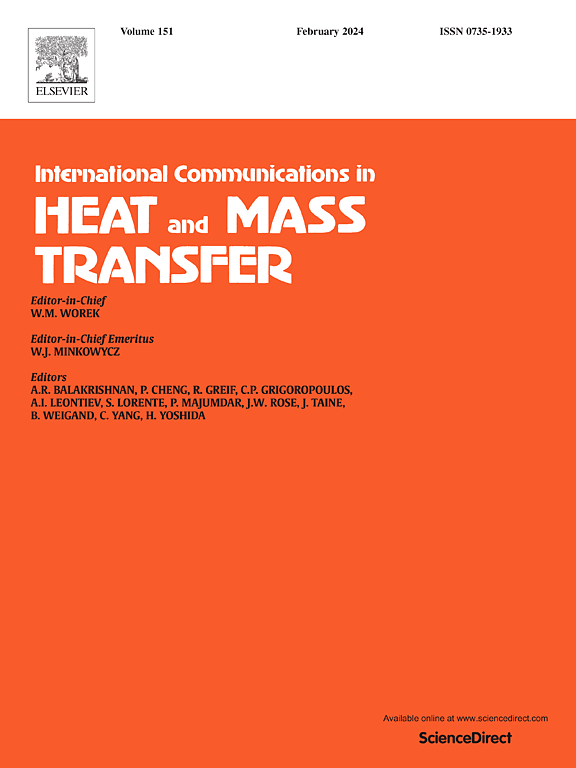Effect of diffuser angle and perforations on the performance of an infrared-suppression (IRS) device under mixed convection
IF 6.4
2区 工程技术
Q1 MECHANICS
International Communications in Heat and Mass Transfer
Pub Date : 2025-05-13
DOI:10.1016/j.icheatmasstransfer.2025.109062
引用次数: 0
Abstract
The flow within an infrared suppression (IRS) device installed on a warship operates under varying thermal regimes, including forced, natural, and mixed convection. While the effects of geometric modifications to the IRS devices have been extensively studied in forced and natural convection scenarios, their influence in the mixed convection regime remains poorly understood. This study examines the performance of four distinct IRS device configurations—converging, straight, diverging, and a perforated-diverging design under mixed convection conditions for Richardson numbers (Ri) ranging from 0.1 to 10. Numerical simulations are performed to analyze fluid flow and thermal fields, entrainment ratio (ER), exit temperature, pressure recovery coefficient (CPR), and cooling efficiency (η), considering diffuser angles (−5° to +5°) and perforated diffuser rings. The findings reveal that diverging (positive) diffuser angles enhance thermal suppression and achieve higher entrainment ratios compared to converging (negative) diffuser angles in the mixed convection regime. Specifically, varying the diffuser angle from −5° to +5° leads to a notable increase in the entrainment ratio (ER), with improvements of 67 %, 41 %, and 37 % observed at Richardson numbers (Ri) of 0.1, 1, and 10, respectively. Additionally, the perforated-diverging configuration consistently outperformed all other configurations, achieving the highest ER and superior thermal suppression across all Ri. It enhanced the ER by 1.78 times at Ri = 0.1 and 1.4 times at Ri = 10 compared to the converging design, and exceeded the diverging design by 7 % and 2.8 % at Ri = 0.1 and 10, respectively. The results presented in this study contribute to a deeper understanding of IRS design optimization and effective infrared signature mitigation for application in the industrial and defense sectors.
扩散角和穿孔对混合对流下红外抑制装置性能的影响
安装在军舰上的红外抑制(IRS)装置内的气流在不同的热状态下运行,包括强制对流、自然对流和混合对流。虽然几何变化对IRS装置的影响已经在强迫对流和自然对流情况下进行了广泛的研究,但它们在混合对流状态下的影响仍然知之甚少。本研究考察了在理查德森数(Ri)范围为0.1至10的混合对流条件下,四种不同的IRS装置配置(会聚、直、发散和穿孔发散设计)的性能。考虑扩散器角度(- 5°至+5°)和穿孔扩散器环,进行了数值模拟,分析了流体流动和热场、夹带比(ER)、出口温度、压力恢复系数(CPR)和冷却效率(η)。研究结果表明,在混合对流条件下,发散(正)扩散角比收敛(负)扩散角增强了热抑制,并实现了更高的夹带比。具体来说,将扩散器的角度从−5°改变到+5°,会导致吸入比(ER)显著增加,在理查德森数(Ri)分别为0.1、1和10时,其改善幅度分别为67%、41%和37%。此外,射孔分流结构的性能始终优于所有其他结构,在所有Ri中实现了最高的ER和优越的热抑制。在Ri = 0.1和Ri = 10时,ER分别提高了1.78倍和1.4倍,在Ri = 0.1和10时,ER分别比发散设计高7%和2.8%。本研究的结果有助于更深入地了解IRS设计优化和有效的红外特征缓解,以用于工业和国防部门。
本文章由计算机程序翻译,如有差异,请以英文原文为准。
求助全文
约1分钟内获得全文
求助全文
来源期刊
CiteScore
11.00
自引率
10.00%
发文量
648
审稿时长
32 days
期刊介绍:
International Communications in Heat and Mass Transfer serves as a world forum for the rapid dissemination of new ideas, new measurement techniques, preliminary findings of ongoing investigations, discussions, and criticisms in the field of heat and mass transfer. Two types of manuscript will be considered for publication: communications (short reports of new work or discussions of work which has already been published) and summaries (abstracts of reports, theses or manuscripts which are too long for publication in full). Together with its companion publication, International Journal of Heat and Mass Transfer, with which it shares the same Board of Editors, this journal is read by research workers and engineers throughout the world.

 求助内容:
求助内容: 应助结果提醒方式:
应助结果提醒方式:


